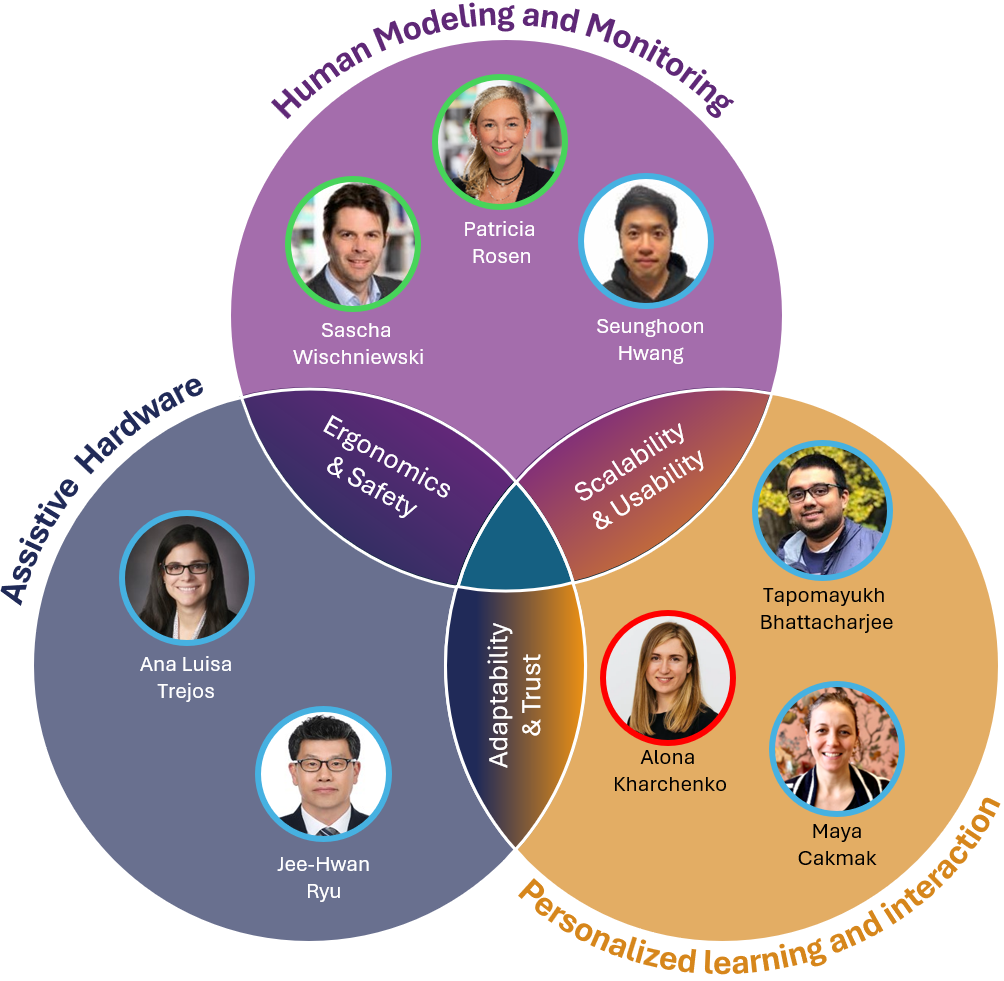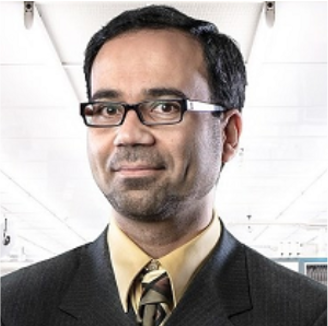
Important Dates.
Notification of acceptance: 1st of May 2025
Camera-ready submissions: 7th of May 2025
Do you plan to join the workshop and want to shape it? You do not need to be an author, just fill out the survey HERE!
We are excited to announce multiple awards, generously sponsored by the IEEE International Conference on Rehabilitation Robotics (ICORR), the IEEE RAS Technical Committee for Cognitive Robotics, and the IEEE RAS Technical Committee for Rehabilitation and Assistive Robotics.
Best Workshop Paper and Video Awards The award for the best extended abstract will recognize the quality of the written submission and the presentation, including engagement during the poster session. Papers with an accompanying video will automatically enter the Best Video Award competition. The video should be a clear, concise (max. 3 minutes) demonstration of the system or experiment. It must adhere to ethical guidelines. Standalone video submissions will only be considered for the best video award and NOT for the best paper award.
Thanks to IEEE RAS Technical Committee for Rehabilitation and Assistive Robotics we have the opportunity to reimburse the registration fee for the workshop days for selected students. So if you are a student and you send a contribution in form of an extended abstract or video you can apply for it through the submission form by providing a short motivation.

Outline and Objectives
Recent advancements in robotics and artificial intelligence (AI) have enabled assistive robots to realize many activities alongside and with humans in shared environments. This physical proximity has introduced novel, complex tasks for the robotics community to address, which can be clustered into three main areas: (i) personal care robots that facilitate humans in physical activities of daily living (ADLs), such as dressing, washing, and feeding, among other personal care tasks through pHRI, (ii) service robots that can perform manipulation tasks for and with humans (doing mobilization and rehabilitation exercises but also handling objects), (iii) physical support robots that provide partial body weight support (BWS) and assist and guide the humans during stance, walking, and other activities (sitting, standing, bending, among other physical-support-based tasks.).
However, despite their potential to transform healthcare and clear beneficial societal impact, such technologies still need to face several unresolved challenges to become part of our everyday lives, including:
- Human Modeling and Assessment: definition of models for online and non-invasive monitoring of the human physical and cognitive state and impairments;
- Assistive Hardware: design of versatile and reconfigurable interfaces and devices that exploit (do not avoid) physical contact for seamless interaction;
- Personalized learning and interaction: developing techniques for learning and adapting robot behavior to individual intentions, actions, and preferences.
This workshop will explore these emerging user-centric tools, particularly focusing on individualized models, adaptive control and planning algorithms, customizable designs and robotic interfaces, and human-informed online learning and optimization techniques.
A prominent theme throughout the workshop is interdisciplinary collaboration, connecting the expertise of academics, occupational experts, and industry partners. We aim to provide a platform for fruitful discussion, inspiring new perspectives and pathways for the community to successfully design and integrate individualized service, care, and physical assistive robots into society.

Topics of interest
We will address a diverse range of topics related to the theme of the workshop, including but not limited to:
- Monitoring of human cognitive and physical ergonomics
- Modeling of humans with mobility constraints
- Human movement and gait analysis
- Prediction of human intentions and actions
- Assessment of trust, comfort, and perceived safety in pHRI
- Human-centered design of physically assistive devices and interfaces
- Smart walking and mobility aids
- Customizable interfaces for physical assistance
- Co-adaptation and personalization of physically assistive robots
- Model-based and model-free control strategies for physical assistance
- Robot learning from human-human physical interaction
- Planning and decision-making for physical assistance
- Safety and robustness in physical assistance
- Design of explainable and trustworthy assistive behaviors
- Challenges and requirements of in-home and in-hospital deployment of physically assistive robots
Program
A tentative schedule of the workshop follows. It may be revised to comply with the conference agenda and to meet the requirements of the invited speakers and contributing authors.
| Time | Description |
|---|---|
| 08.45 – 09.00 | Welcome and Introduction by the organizers |
| 09.00 – 09.30 | Real-time Monitoring and Modelling of Workload - Opportunities and Risks from an Occupational Safety and Health (OSH) Perspective by Sascha Wischniewski & Patricia Rosen |
| 09.30 – 10.00 | Quantitative Characterization of Human Joint Biomechanics and Its Applications by Seunghoon Hwang |
| 10.00 – 10.30 | Contributed Abstract Lightning Talks |
| 10.30 – 11.00 | Coffee Break |
| 11.00 – 11.30 | Poster and Demo Sessions |
| 11.30 – 12.00 | Advances in Soft Sensors and Actuators within Wearable Mechatronic Devices for Motion Assistance by Ana Luisa Trejos |
| 12.00 – 12.30 | Twisted String Actuator-based Soft Exo-suits by Jee-Hwan Ryu |
| 12.30 – 13.30 | Lunch Break |
| 13:45 – 14.00 | TABxStartup initiative session |
| 14.00 – 14.30 | Overcoming Hardware Limits: How Collaboration Between the Elderly and Humanoid Robotic Avatars Enhances Home Care by Alona Kharchenko |
| 14.30 – 15.00 | Contributed Abstract Lightning Talks |
| 15.00 – 15.30 | Coffee Break |
| 15.30 – 16.00 | Poster and Demo Session |
| 16.00 – 16.30 | Towards Robotic Caregiving: Building Robots that Work Alongside Human Stakeholders by Tapomayukh Bhattacharjee |
| 16.30 – 17.00 | Panel Discussion and Award Ceremony |
Invited Speakers
Dr. Sascha Wischniewski & Dr. Patricia Rosen
Head of Human Factors Unit & Senior Researcher, Federal Institute for Occupational Safety and Health (BAuA), Germany (EU)
Talk Title: Real-time Monitoring and Model-ling of Workload - Opportunities and Risks from an Occupational Safety and Health (OSH) Perspective
Abstract: The field of real-time monitoring and modeling of workload to improve human-robot interaction is explored from an occupational safety and health (OSH) perspective. First, an overview of the current landscape of monitoring technologies and instruments, both objective and subjective, is given. The following discussion section will highlight the opportunities and benefits these technologies might offer, such as enhanced productivity and improved worker well-being. However, limitations and potential challenges associated with their implementation will be addressed as well. The talk ends with the key aspects of a comprehensive risk assessment to ensure that the implementation of such technologies aligns with OSH and therefore a human-centered design.
Dr. Seunghoon Hwang
Post-Doc, Neurorobotics Lab, Arizona State University (US)
Talk Title: Quantitative Characterization of Human Joint Biomechanics and Its Applications
Abstract: Characterization of human joint biomechanics, mainly mechanical impedance, is one of the critical techniques to explain and model the neuromuscular system that enables dynamic and stable interactions with the physical environment. This mechanical impedance is essential for maintaining movement stability, especially when navigating unpredictable or destabilizing environments, as it leverages the coordinated actions of bones, ligaments, tendons, and muscles alongside slower neural feedback mechanisms. When successfully characterized, this biomechanics information can help explain differences in injury incidence rates and inform strategies for injury prevention in various conditions. Additionally, it can guide the development of rehabilitation training strategies through comparisons between individuals with neurological disorders and healthy subjects. In this talk, I will present our approach to quantitatively characterizing and modeling human joint impedance using robotic platforms and system identification methods, along with our recent findings and their applications.
Prof. Ana Luisa Trejos
Full Professor, Wearable Biomechatronics Lab, Western Engineering (US)
Talk Title: Advances in soft sensors and actuators within wearable mechatronic devices for motion assistance
Abstract: Wearable mechatronic devices are reshaping the field of motion assistance and rehabilitation, offering new avenues for enhancing human mobility and quality of life. This presentation will delve into the latest advancements in soft sensors and actuators achieved at the Wearable Biomechatronics Laboratory at Western University. These technologies are essential for making wearable devices comfortable and unobtrusive. Soft sensors provide high sensitivity and flexibility, enabling precise motion detection and feedback. Meanwhile, soft actuators offer compliant and adaptive force generation, closely mimicking natural muscle movements. The integration of these technologies within wearable devices not only improves their functionality but also enhances user comfort and adaptability. The talk will also discuss the challenges and future directions in the field, with the aim to inspire further research and development. These advancements are shaping the future of physically assistive robots in healthcare, allowing them to be leveraged to create more effective and user-friendly rehabilitation solutions.
Prof. Jee-Hwan Ryu
Full Professor, Interactive Robotic Systems (IRiS) Lab, Korea Advanced Institute of Science and Technology (KAIST), Republic of Korea (KR)
Talk Title: Advances in soft sensors and actuators within wearable mechatronic devices for motion assistance
Abstract: Industries like construction and shipbuilding place high physical demands on workers, where assistive robotics can play a transformative role in reducing fatigue, improving efficiency, and minimizing injury risks. This talk introduces Twisted String Actuators (TSAs) in soft exo-suits as a lightweight, adaptable, and powerful solution for supporting industrial workers in these demanding environments. With their high power-to-weight ratio and inherent compliance, TSA-driven exo-suits augment human strength, assist with repetitive tasks, and reduce physical strain in physically intensive sectors. The industrial application of TSAs focuses on designing wearable systems that not only aid in load-bearing tasks but also offer flexibility and unobtrusive support. These systems are customizable to adapt to varying physical demands and work conditions, enhancing both user safety and comfort. In addition to industrial applications, the potential of TSA-based exo-suits for rehabilitation will be explored. Soft, compliant actuators can assist individuals with upper-limb impairments in regaining strength and motor function through adaptive, personalized rehabilitation. By leveraging lightweight, efficient actuation, TSA-driven devices provide tailored support for patients in both clinical and home settings. The talk will address the design challenges and considerations for TSA-based exo-suits in industrial and rehabilitation applications.
Prof. Tapomayukh Bhattacharjee
Assistant Professor, Empowering People with Robots and Intelligent Shared Experiences (EmPRISE) Lab, Cornell University (US)
Talk Title: Towards Robotic Caregiving: Building Robots that Work Alongside Human Stakeholders
Abstract: How do we build robots that can assist people with mobility limitations with activities of daily living? To successfully perform these activities, a robot needs to be able to physically interact with humans and objects in unstructured human environments. Through this talk, I will cover various projects in my lab that showcase fundamental advances in the field of physical robotic caregiving that involve complex and uncertain physical human-robot interaction. Specifically, I will show you how we can build caregiving robots to perform activities of daily living such as feeding, meal-preparation, and bed-bathing using our newly developed caregiving simulation tools and algorithms that leverage multimodal perception and user feedback, and how we deployed these systems to work in the real world with real users.
Dr. Alona Kharchenko
Co-Founder and CTO of Devanthro GmbH, Germany (EU)
Talk Title: Overcoming Hardware Limits: How Collaboration Between the Elderly and Humanoid Robotic Avatars Enhances Home Care
Organizers
Dr. Marta Lorenzini
Senior Technician, Human-Robot Interfaces and Interaction (HRII) Lab, Istituto Italiano di Tecnologia (IIT), Italy
Email: marta.lorenzini@iit.it
Dr. Juan M. Gandarias
Assistant Professor, Institute for Mechatronics Engineering and Cyber-Physical Systems (IMECH.UMA), University of Malaga, Spain
Email: jmgandarias@uma.es
Prof. Wansoo Kim
Associate Professor, HumAn-Robot COllaboration (HARCO) Lab, Hanyang University ERICA, Republic of Korea
Email: wansookim@hanyang.ac.kr
Prof. Luis Figueredo
Assistant Professor, University of Nottingham (UoN), UK & Associated Fellow, Technical University of Munich (TUM), Germany
Email: figueredo@ieee.org
Dr. Marta Lagomarsino
Post-Doc, Human-Robot Interfaces and Interaction (HRII) Lab, Istituto Italiano di Tecnologia (IIT), Italy
Email: marta.lagomarsino@iit.it
Dr. Sebastian Hjorth
Post-Doc, Human-Robot Interfaces and Interaction (HRII) Lab, Istituto Italiano di Tecnologia (IIT), Italy
Email: sebastian.hjorth@iit.it
Prof. Mahdi Tavakoli
Full Professor, Telerobotic and Biorobotic Systems Group, University of Alberta, Canada
Email: mahdi.tavakoli@ualberta.ca
Acknowledgments
This workshop will be supported by the European Research Council (ERC) Starting Grant (St-G) Ergo-Lean under grant agreement No. 850932, the European Union's NextGenerationEU framework of the project "Robotics and AI for Socio-economic Empowerment" (RAISE), the National Research Foundation of Korea (NRF) grant funded by the Korea government (Ministry of Science and ICT) No. 2022R1C1C1008306, the INAIL, BRiC 2022 program LABORIUS project (ID 57), and the Spanish Project PID2021-127221OB-I00.

Frequently Asked Questions (FAQ)
Where do I submit my paper or video?
Submit your Abstract and/or Video HERE!
What format should my paper follow?
The paper should follow the following format:
- 2-4 pages (references do not count toward the page limit)
- Follow the IEEE Conf. style
- not exceed 10MB
What format should my video follow?
The video should follow the following format:
- max. duration 3 min
- The file format should be mp4
- not exceed 10MB in size
Do you provide financial support?
If you are a student and you send a contribution in form of an extended abstract or video you may apply for the free registration (through reimbursement). This you can do by applying through the submission form, which requires you to write a short motivation on why we should select you.
Can I fill out the questionnaire also if I do not submit any paper and/or video?
Yes, you can fill out the questionnaire if you want to shape the workshop. You can find the questionnaire HERE!
Can I send already published work?
Yes, you can submit already published work but original works are welcome.
Will my abstract and/or video be published?
Selected extended abstracts/videos will have the opportunity to be archived on this website, but if you prefer not to publish your work, it will be kept confidential
Others questions
For any other questions feel free to contact us under: marta.lagomarsino@iit.it with the subject "Workshop ICRA25"














